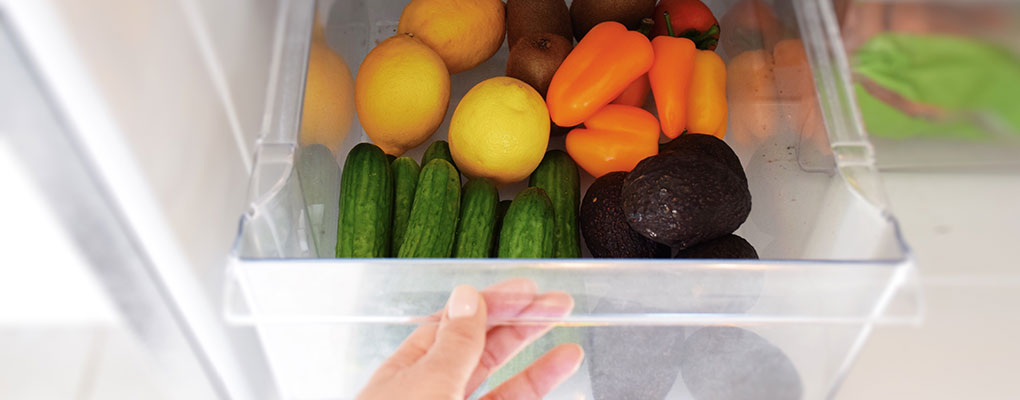COVID-19 has certainly created a number of challenges for people regarding healthy eating. Early on, many people panic bought and hoarded food items. Even now some of the ongoing supply chains are struggling to catch-up, with basic items such as flour, tinned goods, pasta and eggs periodically missing from grocery store shelves. Luckily, fresh produce is still readily available, easily accessible and able to be stored at home for longer than you may think.
According to the CSIRO, all food
has a shelf life that varies depending on the food type, how it is packaged and
stored. If food is stored properly it will maintain good condition (nutrition)
and be safe from the growth of food poisoning bacteria. An additional benefit
of storing food correctly is that it can help reduce food waste and even save
you money!
Perishable foods include fruits,
vegetables, fresh meats, foods purchased from the chill cabinets (i.e. dairy)
and any foods that have been freshly cooked.
Let’s review some basic food
storage tips for perishable (fresh) foods:
- Between 5˚C and 60˚C is known as the “temperature danger zone” for perishable food items. This is the temperature range in which harmful bacteria can multiply. Because of this, it is important to store fresh produce in a refrigerator at or below 5 ˚C. Double check your fridge settings and make sure you have the correct settings to prevent your food spoiling sooner than it needs to. Some fresh produce will store well out of the refrigerator as long as they are stored in a cool place.
- If you plan to freeze food, this needs to be done at -18 ˚C to stop bacterial growth and slow the chemical changes in food that affect its quality. Remember that foods such as minced, rolled and/or stuffed meats and poultry should be completely thawed before cooking. This is best done in the refrigerator (at or below 5˚C).
- Don’t overfill the crisper – space between food items allows cold air to move over the food, preventing the growth of food poisoning bacteria.
- Avoid buying swollen chilled foods – Chilled juices, unprocessed cheeses, yoghurt and fresh pasta all contain harmless spoilage microbes when packaged. Swelling is a sign that microbes have been allowed to grow and produce gas. This usually means the products have been stored for some time at warm temperatures or that they are near the end of their shelf life.
- Ready to eat foods (for example salad or cooked quiche) should be stored on shelves above uncooked food such as raw meat to prevent any juices from the raw food dripping onto ready to eat foods.
- Raw meats, fish and poultry should be stored well wrapped or contained to prevent their juices leaking onto other foods or the inside of the refrigerator.
- Re-hydrated foods and opened cans need to be treated as perishable and refrigerated accordingly.
- Do not store opened foods in cans as tin and iron can dissolve into the food spoiling the flavour.
- Transfer the leftover food to a glass or plastic container before refrigerating.
Right, now we’ve covered the
basics of food safety regarding storage, let’s go over some practical tips to
improve the shelf life of fruits and vegetables! That way you can visit the
grocery store less during COVID19, helping to reduce the likelihood of its
community transmission.
- Fruit and vegetables should be handled carefully to avoid bruising and breaking of the skin – this can encourage deterioration and rot. Most fresh produce is also temperature sensitive and should be stored in a cool part of the house when fridge space is at a premium. Tropical fruits, like pineapple and bananas, are chill sensitive and should NOT be stored in the fridge.
- Leafy greens and root vegetables should be stored in a perforated container in the fridge. Removing the greens from certain vegetables, like carrots, parsnips and beetroot can extend their safe storage life to many weeks or even months in the refrigerator (at or below 5˚C).
- Potatoes and onions should be kept in a cool, dark, well-ventilated place to avoid greening and sprouting. Ideally store in a paper bag, box or in a wire bin. Sweet potatoes are cold sensitive and should not be kept in the fridge. To reduce mould growth in onions, whole pumpkin, marrows and squashes, store at room temperature under dry conditions, in a net or loose.
- Cool climate fruits such as apples, pears and berries should be stored in a perforated container in the fridge to prevent sweating. So too should stone fruits.
- Citrus fruits, passionfruit, cucumbers, capsicum and eggplant lose water easily when refrigerated. They are best stored in your fridge in wax paper or a plastic bag, then allowed to ripen at room temperature prior to eating. Rockmelon, pineapple, pawpaw, bananas, mangoes, avocado, stone fruit, tomatoes and pears need to be ripened at room temperature.
- If storing large amounts of fruit, remove overripe and injured fruit regularly as these will trigger ripening and subsequent aging in the remaining fruit. Also remove any rotting fruit as infection can spread to other fruit.
With a little tweaking to your food storage practises you can expect to eat well for longer, without having to duck to the shops every other day! You may just save a little by reducing food waste too.
